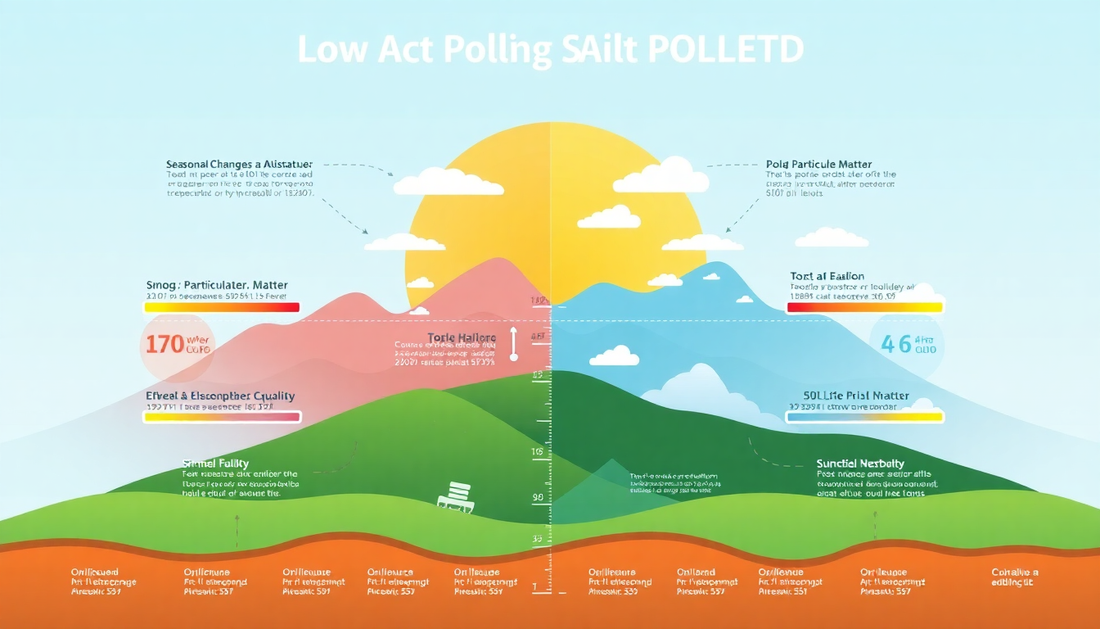Air pollution is a pressing global issue that affects the health and well-being of millions of people worldwide. While the sources and composition of air pollutants can vary significantly, it is crucial to understand how seasonal changes and temperature fluctuations can influence the dynamics of air pollution. In this comprehensive blog post, we will explore the intricate relationship between seasons, temperature degrees, and their impact on air quality.
Seasonal Dynamics of Air Pollution
Winter Pollution Characteristics
During the winter months, air pollution can become particularly problematic due to a combination of factors. One of the primary contributors is the phenomenon of temperature inversions, where a layer of warm air traps cooler air near the ground, preventing the vertical dispersion of pollutants. This trapping effect can lead to a significant buildup of emissions from sources such as residential heating, industrial activities, and vehicle exhaust.
Furthermore, the colder temperatures during the winter season often result in increased energy consumption for heating, leading to higher emissions from power plants and other heating sources. The reduced air circulation and mixing during this time can further exacerbate the problem, as pollutants are unable to dissipate as effectively.
Summer Pollution Patterns
In contrast, the summer months can also present their own set of air pollution challenges. Elevated temperatures and increased solar radiation can trigger photochemical reactions, leading to the formation of ground-level ozone, a key component of smog. Ozone is a secondary pollutant, meaning it is not directly emitted but rather formed through complex chemical reactions involving primary pollutants, such as nitrogen oxides (NOx) and volatile organic compounds (VOCs).
Additionally, the urban heat island effect, where urban areas experience higher temperatures compared to surrounding rural areas, can contribute to the acceleration of these photochemical reactions, further exacerbating the ozone problem. This can have significant implications for public health, as exposure to high levels of ozone can cause respiratory issues and other health problems.
Temperature Degrees and Pollution Interaction
Low-Temperature Impact
The relationship between temperature and air pollution extends beyond the seasonal variations. Colder temperatures can also have a direct impact on the behavior and concentration of air pollutants. During periods of low temperatures, emissions from sources such as residential heating and industrial processes can become trapped near the ground, leading to higher concentrations of particulate matter and other pollutants. This is due to the reduced atmospheric dispersion and the tendency for pollutants to remain closer to the surface.
High-Temperature Consequences
Conversely, higher temperatures can also exacerbate air pollution challenges. Elevated temperatures can accelerate the chemical reactions that lead to the formation of secondary pollutants, such as ozone and certain types of particulate matter. This can result in increased concentrations of these harmful substances in the air, posing a greater risk to public health.
Furthermore, high temperatures can contribute to the formation of photochemical smog, a mixture of various air pollutants that can reduce visibility and cause respiratory problems. The combination of high temperatures, intense sunlight, and the presence of precursor pollutants can create a perfect storm for the generation of this type of air pollution.
Regional Variations
It is important to note that the impact of seasons and temperature degrees on air pollution can vary significantly across different regions and climates. Factors such as geography, urban planning, and local emission sources can all play a role in shaping the unique air pollution profiles of different areas.
For example, regions with a more continental climate may experience more pronounced seasonal variations in air pollution, with stark differences between winter and summer conditions. In contrast, coastal or maritime regions may exhibit different patterns due to the moderating influence of nearby bodies of water.
Mitigation Strategies
To address the challenges posed by the seasonal and temperature-driven dynamics of air pollution, a multifaceted approach is necessary. Policymakers, urban planners, and environmental agencies must implement a range of mitigation strategies that target both the sources of emissions and the environmental factors that contribute to the problem.
Some key strategies may include:
- Implementing seasonal pollution control measures, such as temporary restrictions on certain activities or the use of cleaner fuels during high-pollution periods
- Investing in technological solutions, such as advanced emission control systems, renewable energy sources, and energy-efficient building designs
- Developing and enforcing stricter regulations on industrial emissions, vehicle standards, and residential heating requirements
- Promoting public awareness and encouraging individual actions, such as reducing energy consumption, using public transportation, and adopting eco-friendly practices
By understanding the complex interplay between seasons, temperature degrees, and air pollution, we can develop more effective and targeted strategies to address this pressing environmental challenge and safeguard the health and well-being of communities worldwide.
Conclusion
The impact of seasons and temperature degrees on air pollution is a multifaceted and dynamic phenomenon that requires a comprehensive understanding. From the trapping effects of temperature inversions in winter to the accelerated photochemical reactions in summer, the seasonal variations in air pollution patterns can have significant implications for public health and the environment.
By recognizing the intricate relationship between temperature, climate, and air quality, policymakers, urban planners, and individuals can work together to implement effective mitigation strategies and foster a cleaner, healthier future. Continued research, technological advancements, and collaborative efforts will be crucial in addressing the complex challenge of air pollution and its seasonal and temperature-driven dynamics.

